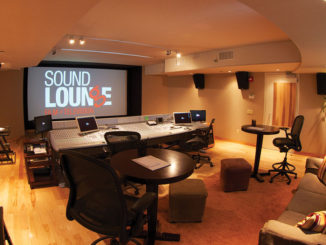
by Mel Lambert
CineMontage: Greg, how do you set up for a mix on an effects-heavy movie like Transformers: Dark of the Moon?
Greg Russell: Having worked with the same basic crew, including supervising sound editors Ethan Van der Ryn and Erik Aadahl, on two previous Transformers films, we have developed a formula for the effects food groups that would come to the stage as well as how the elements would be broken out. I worked toward a total of eight robot pre-dubs and 14 hard effects pre-dubs, plus four background and four Foley pre-dubs.
For robots, I first started with the feet, literally building the mix from the ground up. Then I moved onto bigger metal movements and the medium metal movements, right on down to the eyelash clicks. The other food groups included vocalizations––the robot language and tonalities are in the effects, not part of dialogue. The hard effects included vehicles, skids, cars, jets, trucks, helicopters, human artillery, and fire and explosions, plus some props and Foley elements, as well as touchy-feely stuff like paper downs and so on. Since I prefer to do all the panning, these mono elements comprise maybe 20 or 25 tracks for each food group.
CM: How do you work with the sound editorial crew?
GR: The sound editors are pretty disciplined by now; they are more concise in what they bring to the stage and they don’t over-cut. If necessary, ProTools sessions can be opened and an element refined without the need to re-cut the track. In the old days of 35mm mag, editors didn’t want to commit and would over-cut, meaning that I spent my time weeding out things I didn’t need.
CM: Michael, how important is sound to your movies?
Michael Bay: Sound is 50 percent of the movie; it is critical. Transformers: Dark of the Moon is an effects-heavy movie, stylized and beautiful. Greg Russell is a key to its success.
We consistently try and make my movies the best sounding we’ve ever done. As James Cameron told me the other day when I played him an in-progress mix: “It’s f*cking epic!” We were in the middle of mixing the wall-to-wall sound in Act 3, as we’re preparing for the Battle of Chicago with a few characters in the middle of the city. It is all too easy for the mix to become too overwhelming. I rely on Greg to keep me grounded. You can make it totally loud, but then you have nowhere to go in terms of dynamics. Less, quite often, can be more for a movie soundtrack.
“The sound weaves around the action; it is just staggering what a good mix these talented people can produce. I look for creativity in my re-recording crew—people who come up with something fresh and new for me.” – Michael Bay
CM: What does Greg Russell bring to your productions?
MB: I’ve been working with Greg since 1996; he is fantastic at his job. I prefer to weave the sound so that audiences can hear important cues and I can focus their attention on specific elements. A director basically manipulates audiences in terms of guiding where he wants their eyes to go from shot to shot. It is exactly the same with sound; we use it as a tool to have the audience hear exactly what is important in the film. It is how you focus the audience with sound effects, which can all too often dominate the action.
CM: Greg, what did Dolby 7.1 Surround bring to the production?
GR: This was my first 7.1-channel mix, with Gary Summers handling dialogue and Jeff Haboush the music; we had a great time! The four surround channels—left-wall, left-back, right-wall and right-back—offer a full-field quad scenario. If I have a machine gun going “rat-tat-tat” in the right-side surround, a separate “kaboom” in the right-rear adds impact and interest; 7.1 offers creative opportunities to move sounds around the room with much more defined rear-field panning.
Transformers: Dark of the Moon was a very busy mix. I was out to around 256 faders on the Harrison MC-4D at Sony’s Kim Novak Stage, with 32 open-channel sweeteners for things that changed or where we wanted a different sound. We often received new or revised visuals for which I might need to add new material. We just muted tracks in the pre-dub and added the new sweetener tracks.
CM: Michael, what was the standout for you, sound-wise?
MB: Act 3, which focuses on an all-out attack on Chicago, is ridiculously complex. The sound weaves around the action; it is just staggering what a good mix these talented people can produce. I look for creativity in my re-recording crew—people who come up with something fresh and new for me. Ingenuity is the key; people who think outside the box and constantly have a varied approach to the movie’s soundtrack. During pre-production, I get involved with the mixers early; I’m constantly demanding the very best of people.






